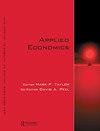Does financial liberalization matter for domestic value added in exports? Evidence from China
IF 1.8
3区 经济学
Q2 ECONOMICS
引用次数: 1
Abstract
ABSTRACTUpstream stages of production chains are often capital intensive, so financial liberalization which improves the availability of financial resources may expand the supply of domestic inputs and then raise domestic value added in exports of downstream firms. After China’s accession to the WTO, China’s government removed the restrictions on foreign banks’ business and allowed foreign banks in China to offer Chinese currency (RMB) services to Chinese firms. We utilize this policy change to test the effects of financial liberalization on Chinese firms’ domestic value added in exports. We have three main findings: (1) domestic value added in Chinese firms’ exports is positively associated with the removal, (2) the removal of foreign bank business restrictions leads to a general change of local financial markets, which facilitates firms’ financing activities and (3) the improvement in domestic value added following the removal is not mainly driven by export mode switching from processing trade to ordinary trade but by the increase in domestic inputs.KEYWORDS: Financial liberalizationdomestic value addedintermediate inputsJEL CLASSIFICATION: G21G28F14 Disclosure statementNo potential conflict of interest was reported by the author(s).Notes1 Regulations of the People’s Republic of China on the Administration of Foreign-funded Financial Banks.2 We thank anonymous referees for this suggestion.3 A Herfindahl-Hirschman Index based on bank loans measures the competition among banks more precisely. However, the data on bank loans are not available to us. So we have to use this alternative measure.Additional informationFundingThis work was supported by the National Natural Science Foundation of China [71703066].金融自由化对国内出口增加值有影响吗?来自中国的证据
生产链的流阶段通常是资本密集型的,因此金融自由化可以提高金融资源的可获得性,从而扩大国内投入品的供应,从而提高下游企业出口的国内附加值。中国加入世贸组织后,中国政府取消了对外资银行业务的限制,允许在华外资银行向中国企业提供人民币业务。我们利用这一政策变化来检验金融自由化对中国企业国内出口增加值的影响。我们有三个主要发现:(1)中国企业出口的国内增加值与取消外资银行业务限制呈正相关;(2)取消外资银行业务限制导致了当地金融市场的普遍变化,这有利于企业的融资活动;(3)取消外资银行业务限制后国内增加值的提高主要不是由出口方式从加工贸易转向普通贸易驱动的,而是由国内投入的增加驱动的。关键词:金融自由化国内增加值中间投入jel分类:G21G28F14披露声明作者未报告潜在利益冲突。注1《中华人民共和国外资金融银行管理条例》。2我们感谢匿名推荐人的建议以银行贷款为基础的赫芬达尔-赫希曼指数(Herfindahl-Hirschman Index)更准确地衡量了银行之间的竞争。但是,我们没有银行贷款的数据。所以我们必须使用另一种方法。本研究得到国家自然科学基金资助[71703066]。
本文章由计算机程序翻译,如有差异,请以英文原文为准。
求助全文
约1分钟内获得全文
求助全文
来源期刊

Applied Economics
ECONOMICS-
CiteScore
3.80
自引率
4.50%
发文量
525
期刊介绍:
Applied Economics is a peer-reviewed journal encouraging the application of economic analysis to specific problems in both the public and private sectors. It particularly fosters quantitative studies, the results of which are of use in the practical field, and thus helps to bring economic theory nearer to reality. Contributions which make use of the methods of mathematics, statistics and operations research will be welcomed, provided the conclusions are factual and properly explained.
 求助内容:
求助内容: 应助结果提醒方式:
应助结果提醒方式:


